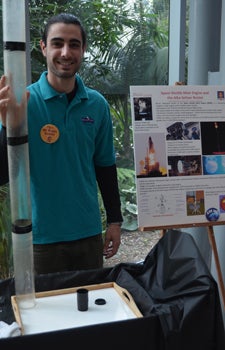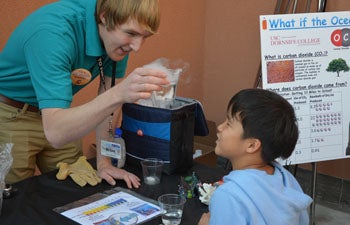Dissolving Away Confusion
USC Dornsife senior Vahak Bairamian dropped an Alka-Seltzer tablet into a small plastic container filled with water and closed the lid. The container was encased in a long, vertical tube.
The audience at the California Science Center (CSC) held its breath — then, boom! People jumped as the lid flew off the container with tremendous force — hitting the top of the tube.
This simple demonstration showing the buildup of pressure helped visitors visualize propulsion used in a space shuttle engine. During his presentation, Bairamian noted that the shuttle launches into space thanks to a high pressure reaction between liquid oxygen and liquid hydrogen, which generates an upward thrust equivalent to 37 million horsepower.
Bairamian was one of eight students who recently presented projects at the CSC as part of “Communicating Ocean Science,” a class led by Myrna Jacobson Meyers, assistant research professor of biological sciences at USC Dornsife.

Vahak Bairamian, a USC Dornsife senior majoring in biology, stands with the Alka-Seltzer rocket he used to demonstrate how a space shuttle’s engines work. Photo by Erica Christianson.
The course, taught every other year, is assisted by Emily Yam, science interpretation coordinator, and David Bader, director of education, both of the Aquarium of the Pacific, and the California Science Center, home to the space shuttle Endeavour.
Jacobson Meyers’ team has taught the course content to National Oceanic and Atmospheric Administration Knauss fellows in Washington D.C. to help them communicate science better to Congress and lobbyists. They have also conducted workshops for teachers in the community, and held joint workshops with various schools at USC.
Jacobson Meyers believes it is crucial for scientists to be able to communicate their work, whether to policymakers, the public, or other scientists. One example of what is taught in the course is how to frame a conceptual scientific discussion.
“When we first presented the changes that are happening on our Earth due to increases in carbon dioxide emissions, we framed the concept as global warming and we spoke about a greenhouse effect,” Jacobson Meyers said. But most people have never seen a greenhouse and those who have, perceive them as a good place to protect and grow plants. Over the years, the language has changed. Now, the explanation of carbon dioxide’s function in holding heat is expressed as a CO2 blanket around the earth — a more easily understood visual.
Although excellent communication skills are crucial, scientists early on in their careers don’t always find guidance in that area.
“Scientists tend to be somewhat isolated in their research specialty or group,” Jacobson Meyers said. “When students begin their Ph.D.s, they develop early on a code language which is necessary to communicate with peers. The downside of that is that they end up creating a sort of private club. They live in a science box. But if you are doing something important in your box no one will know about it unless you step out and tell them about it.”
To get their message across, the course teaches students to gauge their audience’s knowledge level by asking questions. Then they use storytelling and analogies to convey a concept.
“This class taught me how to engage people and convey information,” Bairamian said. “Through it I’ve learned great communication and research skills.”
Upstairs, USC Dornsife senior Brian Lentz was presenting his research on ocean acidification and its impact on oysters and other organisms with the catchy-titled presentation “What if Oceans were Soda?” In an adjoining booth Nick Klein, who researches gas transfer from the atmosphere to water, was showing people how carbon dioxide could enter the water column to change acidity using gas from balloons that were blown up by participants.
“When ocean water takes in carbon dioxide, it’s kind of like the bubbles in soda that make it more acidic,” Lentz, a biological sciences major, told a group of captivated children and their parents. “Humans make so much carbon dioxide that if we turned it into dry ice every year it would be the equivalent of the size of 18,500 Empire State Buildings. A third of that goes into the ocean, changing its chemistry and making it more acidic, which is bad for sea creatures that make a shell like an oyster.”
The crowd watched attentively as Lentz demonstrated this by dropping a coral substitute made of indigestion tablets into an acidic solution of vinegar and water. A collective sigh went up from his audience as the tablets fizzled and fell apart, before completely dissolving.
“Communication is an essential skill in any career,” Lentz said. “To communicate complicated concepts you need to be able to assess someone’s prior knowledge and tailor your choice of words, terms and concepts accordingly so you can really connect and have a meaningful exchange. After taking Dr. Jacobson Meyer’s class I feel I can communicate almost any concept — no matter how complicated —to any audience.”

USC Dornsife biological sciences senior Brian Lentz uses indigestion tablets fizzing in a solution of vinegar and water to explain the effects of ocean acidification on shellfish. Photo by Erica Christianson.
Senior Kevin Kim, who is majoring in biological sciences and aiming for medical school, agreed. “Teaching is a huge part of being human,” Kim said. “So although this class is about communicating ocean science, the skills we are learning are applicable to any field.”
Senior Elaine Krebs, who is majoring in health and humanities at USC Dornsife, is researching how plankton are affected by human waste. She demonstrated an ocean food web by challenging visitors to assemble various colored plastic gears, each representing a different animal so they interconnect as they would in the food chain. By turning a crank and making the interconnected gears spin, visitors were able to visualize the chain reaction between creatures. The removal of one gear prompted a discussion of environmental changes. Then, interdependence of an ecosystem became obvious.
Krebs, who plans to pursue a career in science education, said the course had provided her with valuable tools to be a more effective educator.
Helen Bermudez Foley, a Ph.D. student in marine biology, knows the power of communication firsthand. “I got into science because when I was a kid someone explained biology to me in a fascinating way. That’s what I want to do. I want to bring science to people and let them play a role because science is not just a spectator sport.”
Bermudez Foley, who is studying genetic coding in sticklebacks, cut out paper fish with different numbers of spikes and asked passersby to match each fish with its DNA code, which she had noted on separate strips of paper. Her goal: to explain how organisms’ stress-coping mechanisms are explained by DNA.
“At first glance, a fish with more defensive spikes has an advantage over one with fewer,” she said. “However, if making each spike costs a certain amount of energy, a fish with fewer spikes can conserve some of that energy and use it for something else. The kids watching today have come up with great suggestions about how they can use it to swim faster or be smarter than their predators.”
The presentations forced students to strip complex research down to basics and find effective analogies to explain key concepts to a diverse audience with widely differing levels of knowledge.
Lentz reflected on what he’s learned from the class.
“Before taking this course, I underestimated the importance of effective communication, which I believe is common in the scientific community,” he said. “Scientists often do not spend nearly enough time thinking about how their research can most effectively be communicated to the public and policymakers.
“I took a complicated subject, ocean acidification, and made it understandable to children and adults of all ages and educational backgrounds.”